|
|
|
Sort Order |
|
|
|
Items / Page
|
|
|
|
|
|
|
| Srl | Item |
| 1 |
ID:
083481


|
|
|
|
|
| Publication |
2008.
|
| Summary/Abstract |
There was not, except in the very broadest sense, a unified 'Allied' grand strategy regarding any aspect of World War II. British-American strategy and Soviet strategy were formed in isolation. This was certainly true of the strategy of anti-German insurgency. Aside from geographical and ideological factors a major source of difference was that Britain was at war with Germany from September 1939, while the USSR and the USA became involved two years later. There were major asymmetries: Moscow's insurgency strategy for most of the war was in practice applied to its own national territory, while British (and later American) insurgency strategy was applied to foreign countries occupied by Germany. It will be argued, however, that in different parts of the Grand Alliance the path of insurgency strategy followed a similar trajectory, even if this strategy was not synchronised in time or space. In London, Moscow, and Washington, high hopes were initially placed on popular rebellion in German-occupied territory. It was only months after the entry of their countries into the war that the high commands, both west and east of the Reich, came to the conclusion that insurgent forces could only be used as an auxiliary to huge conventional armies.
|
|
|
|
|
|
|
|
|
|
|
|
|
|
|
|
| 2 |
ID:
115288
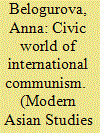

|
|
|
|
|
| Publication |
2012.
|
| Summary/Abstract |
The short history of the Taiwanese Communist Party (Taiwan gongchandang ? ? ? ? ?) (1928-1931) offers a window into the negotiative polity of international communism during the Third Period (1928-1934). The Party was established during the time when the Comintern intensified its operations in colonies and promoted the organization of communist parties there. Its demise was the result of government suppression that occurred as a reaction to their increased public activity in 1931, allegedly at the direction of the Comintern. This paper examines the Comintern's role in the Taiwanese communist movement and shows that the Taiwanese communists were active agents (rather than passive tools) in their relationship with the Comintern.
|
|
|
|
|
|
|
|
|
|
|
|
|
|
|
|
| 3 |
ID:
085414


|
|
|
|
|
| Publication |
USA, University of Washington Press, 1969.
|
| Description |
xviii, 246p.hbk
|
|
|
|
|
|
|
|
|
|
|
|
Copies: C:1/I:0,R:0,Q:0
Circulation
| Accession# | Call# | Current Location | Status | Policy | Location |
| 008508 | 324.251075/THO 008508 | Main | On Shelf | General | |
|
|
|
|
| 4 |
ID:
110057
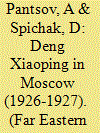

|
|
|
|
|
| Publication |
2011.
|
| Summary/Abstract |
The article dwells in detail on the study period of the future great reformer of China Deng Xiaoping and his fellow students in Moscow in 1926-1927 and is based on the now available documents from the Russian State Archives of Socio-Political History (RSASPH). It analyzes the questions involved in the ideological, theoretical and party-political training of Deng Xiaoping at one of the leading Comintern study centers - Sun Yat-sen Communist University of the Toilers of China. The authors come to the conclusion that everything achieved by Deng during his studies had a decisive influence on the formation of his Marxist views. And the fact that "socialism with Chinese characteristics," which emerged in China, resembles in many respects the Soviet New Economic Policy (NEP) was largely due to the education received by Deng in the Soviet Union.
|
|
|
|
|
|
|
|
|
|
|
|
|
|
|
|
| 5 |
ID:
147714


|
|
|
|
|
| Summary/Abstract |
This paper examines the rise of ISIL in the context of wider debates in the first half twentieth century on the nature and political direction of the early Bolshevik state model of Lenin, Trotsky, and Stalin. It argues that there are some parallels between the Trotskyite internationalist tendency in Soviet Russia and of ISIL given the latter’s calls for revolutionary jihad against both ‘apostate’ states in the Islamic world and, in the longer term, against the Western world as a whole. ISIL though is distinguished by its attempt to carve out a new state formation of its own in parts and Iraq and Syria, a project that may well end in failure. However, even if its so-called caliphate fails, it cannot be expected to vanish from the scene since it can either re-emerge elsewhere in a region of weak or failing states or merge with its current rival Al Qaeda.
|
|
|
|
|
|
|
|
|
|
|
|
|
|
|
|
| 6 |
ID:
110216
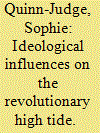

|
|
|
|
|
| Publication |
2011.
|
| Summary/Abstract |
Over the years, Hanoi historians have presented different views of the role of communist organizers in the events of 1930-31. Thanks to the opening of the Comintern archives, we can now see that in 1929-30 there was a strong shift in international communism towards revolutionary violence in all parts of the world. This paper discusses the ideological precedents and influences reaching Vietnam from Russia and the Comintern, as well as from the Chinese revolutionary movement. These include the slogans and political analysis of colonial countries that the Comintern and its agents were popularizing in Moscow, Paris and China. They also include the experience of peasant revolt in southern China, in particular what became known as the Hai-lufeng Soviets in Guangdong province in 1927-28, as well as Chinese left-wing politics of 1928-30, when Li Lisan was a dominant force. The author explores the idea that violent anarchism, with roots in the theories of early Russian revolutionaries, may have been a link between these disparate influences. An examination of the attitudes expressed by different Vietnamese communist leaders towards the revolutionary violence of 1930-31 forms an important part of this paper. To what extent were they in tune with the Comintern? Did they find other sources of inspiration closer to home? Were they simply riding a wave of peasant anger? In conclusion, the author discusses conceptions of what the Revolutionary High Tide represented in terms of political change in Vietnam. Was it the coming of age of the proletariat; an expression of peasant grievances that got out of control; or a first step on the path to independence?
|
|
|
|
|
|
|
|
|
|
|
|
|
|
|
|
| 7 |
ID:
192260
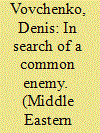

|
|
|
|
|
| Summary/Abstract |
The uneasy Putin-Erdogan partnership reminds of the early twentieth-century trends in the Russo-Turkish relations – taking advantage of each other’s dissidents vs cooperating against Western imperialism. Imperial Russia tended to indulge in the former which undermined the latter tendency in its policies in regards to the Young Turk regime who were similarly making irredentist overtures to Russian Muslim minorities. Both sides were also tempted or constrained by their existing or potential Great Power allies. In contrast, the partnership between the Soviets and Mustafa Kemal Ataturk would be more consistent as they minimized meddling in each other’s internal affairs to jointly oppose European encroachments. This article also shines a new archival light on the motivations of the Soviet side while highlighting the less well-known opposition to close cooperation between traditional rival empires on all levels of Soviet leadership. There is no scholarly work focusing on the 1908–1923 period in a single monograph or article (from the Young Turk revolution to the Lausanne negotiations). Looking at both sides of the 1917 divide reveals surprising continuity between the imperial and the Soviet policies despite the earthshattering effects of the First World War.
|
|
|
|
|
|
|
|
|
|
|
|
|
|
|
|
| 8 |
ID:
145621


|
|
|
|
|
| Summary/Abstract |
This article examines the process of development of the political left since its inception in Turkey in a context when the republic was established as a nation state and 1917 October Revolution. It looks at how the movement has been transformed with the collapse of the Soviet Union and with the changes in domestic politics. The historical process of the Turkish left is divided into three eras: The first from the beginning of the republic to the 1960s; the second from 1960 to 1980; and the third from 1980 to the present day. In this era, the left has not had that organized structure and influence as in the second era.
|
|
|
|
|
|
|
|
|
|
|
|
|
|
|
|
| 9 |
ID:
124813


|
|
|
|
|
| Publication |
2013.
|
| Summary/Abstract |
SITTING IN THE RUSSIAN STATE ARCHIVES for Socio-Political History (RGASPI), formerly the Marx-Engels-Lenin Institute, on Bolshaya Dmitrovka Street in Moscow, I hold in my hands a top secret, until recently, folder with unique documents in Russian, Spanish and English.
It contains materials from the history of the organization with the name exotic even for political gourmands. I mean the Paraguayan Communist Party (PCP) of the mid-1930s.
|
|
|
|
|
|
|
|
|
|
|
|
|
|
|
|
| 10 |
ID:
123405
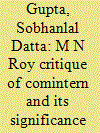

|
|
|
|
|
| Publication |
2013.
|
| Summary/Abstract |
It is customary to associate M.N. Roy with the Comintern years ( 1920-1928) and highlight his achievements as a leading Comintern functionary primarily in the capacity of a key theoretician of the colonial question. Our attention is thereby generally drawn towards his debate with Lenin in 1920 in the Second Congress and the adoption of his Supplementary Theses on the Colonial Question, apart from his speeches on India and the colonial question in the different Congresses and Plena of the Comintern.
|
|
|
|
|
|
|
|
|
|
|
|
|
|
|
|
| 11 |
ID:
159321
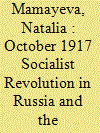

|
|
|
|
|
| Summary/Abstract |
China experienced the strongest influence of Russia during the years of the October 1917 Revolution and the postrevolution period. An important role in China was played by the ideological and cultural impact of Russia on the New Culture Movement in the country (1915-1925), on whose basis the May Fourth Movement (1919) developed, and an upsurge of the revolutionary movement in China in 1925-1927. A study of the ideological and cultural aspects of the interaction and influence of Marxism-Leninism on China focuses on the common actions of the two sides on the spheres of ideology, culture, and democracy, and demonstrates the specific features of historical process in China.
|
|
|
|
|
|
|
|
|
|
|
|
|
|
|
|
| 12 |
ID:
162822
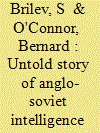

|
|
|
|
|
| Summary/Abstract |
THIS is the continuation of our efforts to find out who were the women whom Soviet intelligence planted as secret agents in Western Europe via Britain in 1941-1943. They went ashore in the UK with Soviet passports to the names of Maria Dicksen, Yelena Nikitina, Emilia Novikova, Anna Uspenskaya, and Anna Frolova.
|
|
|
|
|
|
|
|
|
|
|
|
|
|
|
|
|
|
|
|
|